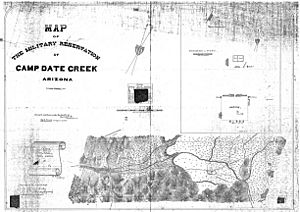Hualapai War facts for kids
Quick facts for kids Hualapai War |
|||||||
|---|---|---|---|---|---|---|---|
| Part of the American Indian Wars, Yavapai Wars | |||||||
 A map of Camp Date Creek and the adjoining Hualapai reservation in 1869. |
|||||||
|
|||||||
| Belligerents | |||||||
| Hualapai Yavapai Havasupai |
|||||||
| Commanders and leaders | |||||||
| Anasa † Wauba Yuba † Sherum Leve Leve Hitchi Hitchi Hualapai Charley |
|||||||
| Strength | |||||||
| unknown | ~250 warriors | ||||||
The Hualapai War, also called the Walapai War, was a conflict that took place from 1865 to 1870. It was fought between the Hualapai people and the United States in Arizona Territory. The Yavapai people also joined the Hualapai. Mohave scouts helped the United States Army.
The war started after a respected Yavapai leader named Anasa was killed in April 1865. This led to Native Americans raiding American settlements. The United States Army then responded. By 1869, many Hualapais had to surrender because of illness. However, some fighting continued for almost two more years.
Contents
Why the Hualapai War Started
Tensions grew between the Hualapai people and new settlers. This happened as settlers moved onto Hualapai lands. The Hualapai lived in the area between the Grand Canyon and the Bill Williams River.
New Roads and Gold Bring Settlers
In 1857, Edward Fitzgerald Beale created a road through Hualapai territory. This road led to Needles, California. Then, in 1863, gold was found in the Prescott Valley. This discovery caused a "gold rush." Many miners and other settlers came to the area.
In 1864, Captain William Hardy built a toll road. This road went through Hualapai land. It connected Prescott and Bull Head City, which was then called Hardyville. The road later expanded to other places. Hardy became wealthy by running a ferry across the Colorado River. He also charged settlers to use his road.
The Killing of Leaders and Renewed Fighting
At first, relations with the Native Americans were mostly peaceful. However, in April 1865, some settlers killed Anasa during a meeting. This event made the Yavapai people decide to go to war. The Hualapai asked their Havasupai and Yavapai friends for help. They agreed to fight.
Warriors gathered under Chief Leve Leve. He was the half-brother of Sherum and Hualapai Charley, who were also chiefs. About 250 Hualapai warriors joined the fight. An unknown number of Yavapai and Apache allies also helped. They faced hundreds of United States Army troops and local fighters.
Fighting Style and Peace Attempts
The fighting was mostly guerrilla warfare. Small groups of Native Americans would block Hardy's road. They used quick attacks and then disappeared. Captain Hardy tried to make peace. He negotiated a peace treaty with the Hualapai at Camp Beale's Spring. This stopped the raids for a while.
But nine months later, settlers killed another Hualapai chief named Wauba Yuma. This act restarted the fighting.
How the War Ended
The United States Army responded to the renewed fighting. Soldiers from the 8th Cavalry Regiment and the 14th Infantry Regiment fought back. They were led by William Redwood Price. The soldiers fought many small battles. They also burned many Native American villages, called rancherías.
Army Posts and Disease
The Army built new posts to help them fight. These included Camp Date Creek, built in January 1867. Camp Hualapai was built in May 1869. Camp Date Creek was located along Date Creek. It was on the road between Prescott and La Paz. Camp Hualapai was north of Prescott, near Walnut Creek. These posts helped the military control the area.
However, disease played a big role in ending the war. Many Hualapais got sick with dysentery and whooping cough. This forced most of them to surrender by December 1868. Chief Leve Leve surrendered in 1869. Chief Sherum continued fighting until 1870.
Life After the War
Many Hualapais were moved to a reservation at Camp Beale's Spring. Three years later, they moved to the Colorado River Reservation near La Paz. Some went to a temporary reservation at Camp Date Creek. But this post closed by 1874.
Life on the reservations was very hard. People faced hunger and sickness. In 1875, some Hualapai escaped back to their traditional lands. But they found that others had already settled there. The Hualapais then either went back to the reservation or found work in mines or on ranches.
In 1882, a 900,000-acre reservation was created for the Hualapai. But this land was not good. The weather was harsh, and ranchers' cattle destroyed many native plants. These plants were important food sources for the Hualapai. It is believed that one-third of the Hualapai population died between 1865 and 1870.
Images for kids


